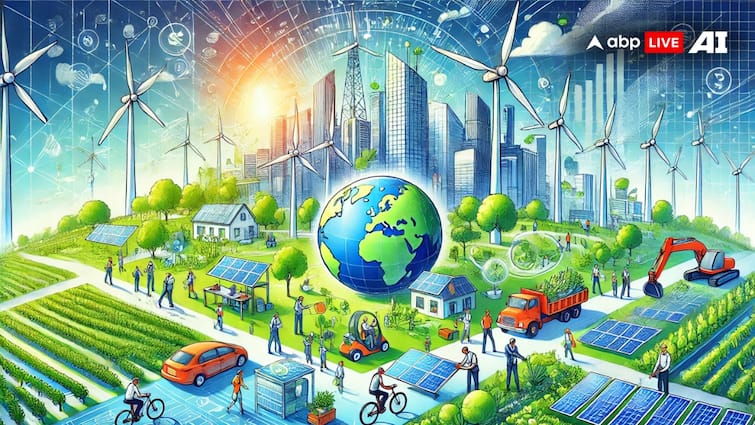


Dr. Prasad Kulkarni
The transition to a sustainable future has led to a surge in demand for green jobs, positioning them as one of the most promising career paths worldwide. Green jobs, defined by the International Labour Organization (ILO), encompass roles that contribute significantly to preserving or restoring environmental quality. From renewable energy engineers to sustainable urban planners, these jobs are at the forefront of combating climate change and fostering economic resilience.
According to the United Nations (UN), achieving net-zero emissions by 2050 could create 24 million green jobs globally by 2030. This transformation is fuelled by investments in renewable energy, sustainable agriculture, and waste management. For instance, the International Renewable Energy Agency (IRENA) reported that the renewable energy sector alone employed 12.7 million people in 2022, a 4% increase from 2021. Solar photovoltaic (PV) energy and wind power were the largest contributors, with countries like China, the United States, and Germany leading the employment surge.
India, under its ambitious renewable energy goals, has also made significant strides. The Ministry of New and Renewable Energy (MNRE) projected that meeting its target of 500 GW of renewable energy by 2030 could create nearly 3.3 million jobs. Already, the solar energy sector in India employed over 100,000 people as of 2022, reflecting a sharp rise due to supportive government policies and international partnerships.
ALSO READ ON ABP LIVE | Narayana Murthy Says Climate Change Could Lead To Mass Migration To Cities Like Bengaluru And Pune
Germany: A leader in green job creation, Germany’s “Energiewende” policy aims to transition the country’s energy system to renewable sources. This shift has generated over 300,000 jobs in the renewable energy sector. Government-backed training programs ensure that workers from declining industries, like coal, are seamlessly integrated into greener roles.
United States of America: The Inflation Reduction Act of 2022 marked a landmark investment of $369 billion in clean energy and climate initiatives. The Act is expected to create up to 1.5 million jobs by 2030, primarily in solar, wind, and energy-efficient technologies. Cities like Austin, Texas, and San Francisco are becoming hubs for green startups, fostering local employment.
India: With schemes like the National Electric Mobility Mission Plan, India is emerging as a global leader in electric vehicle (EV) manufacturing and adoption. The EV sector employed approximately 150,000 people in 2023, with projections indicating a fivefold increase by 2025. Additionally, partnerships with organisations like GIZ have been instrumental in promoting vocational training for green jobs.
South Africa: In a bid to move away from coal dependency, South Africa’s Just Transition framework is creating job opportunities in renewable energy projects. The initiative aims to retrain 30,000 workers displaced from the coal sector by 2030.
ALSO READ ON ABP LIVE | 89% Of Delhi-NCR Schoolchildren Worried About Climate Change: Report
Global organisations like the UN, GIZ, and WHO are spearheading initiatives to expand green job opportunities. For example:
Despite the optimistic outlook, challenges persist. A report by the International Energy Agency (IEA) highlighted skill mismatches as a significant barrier to green job expansion. For instance, while there is a growing need for solar panel installers, engineers, and technicians, many regions face a shortage of trained professionals.
However, these challenges also present opportunities. Governments and private entities are ramping up investments in green education and training programs. For example, the Government of India’s “Green Skill Development Programme” (GSDP) has trained over 300,000 individuals in fields like afforestation and biodiversity conservation since 2021.
Students now have exciting opportunities to shape a greener future through a variety of emerging careers:
The growing green sector not only offers fulfilling careers but also provides students with the chance to make a meaningful, lasting impact on the world.
The allure of green jobs extends beyond environmental impact. They offer competitive salaries and long-term stability. For instance, the average salary of a wind turbine technician in the US is $56,260 annually, higher than many traditional roles. Moreover, these jobs are often concentrated in regions with high growth potential, enhancing local economies.
As industries and governments increasingly prioritise sustainability, the demand for green jobs is set to soar. Whether it’s designing energy-efficient buildings or innovating in waste-to-energy technologies, the green economy is proving to be a cornerstone of global development.
For individuals, aligning career aspirations with sustainability is not just a professional opportunity but also a chance to contribute to a healthier planet. With the support of international initiatives and forward-looking policies, green jobs are not merely an emerging trend but a defining feature of the global workforce in the 21st century.
Dr. Prasad Kulkarni is Head & Assistant Professor, Department of Environmental Studies, MIT- World Peace University, Pune.
[Disclaimer: The opinions, beliefs, and views expressed by the various authors and forum participants on this website are personal and do not reflect the opinions, beliefs, and views of ABP Network Pvt. Ltd.]
Education Loan Information:
Calculate Education Loan EMI